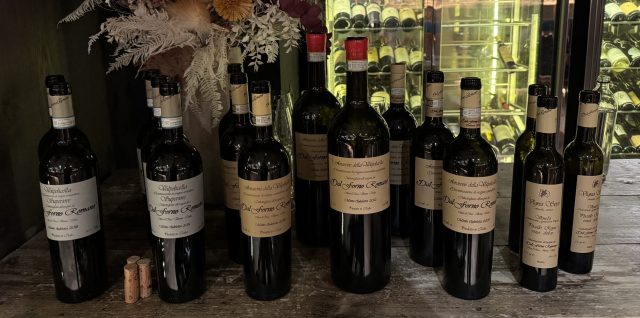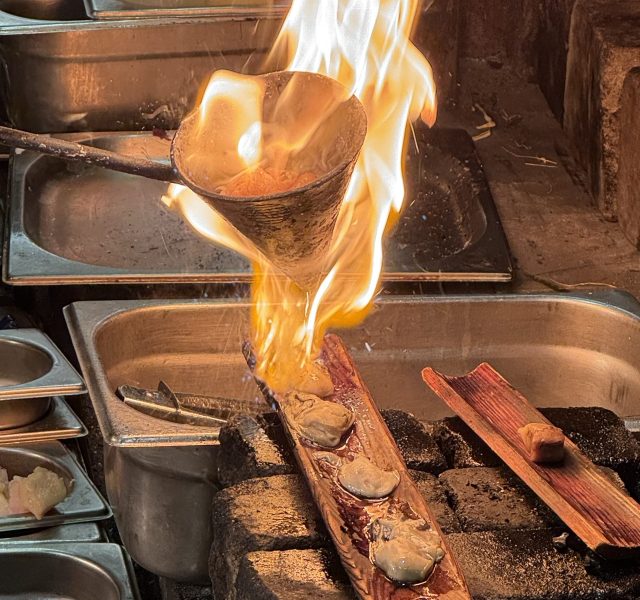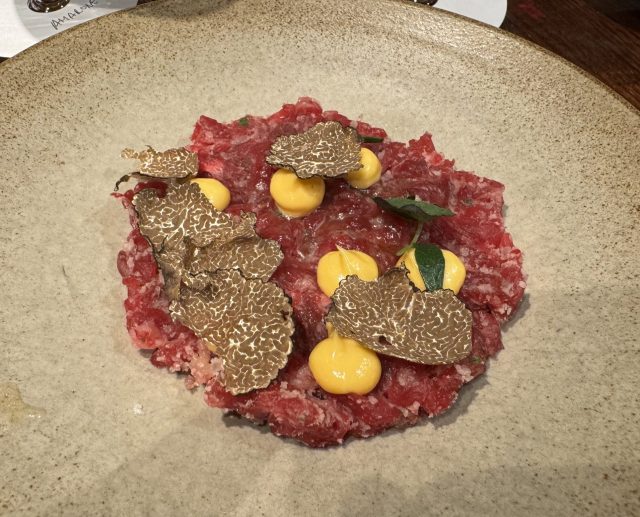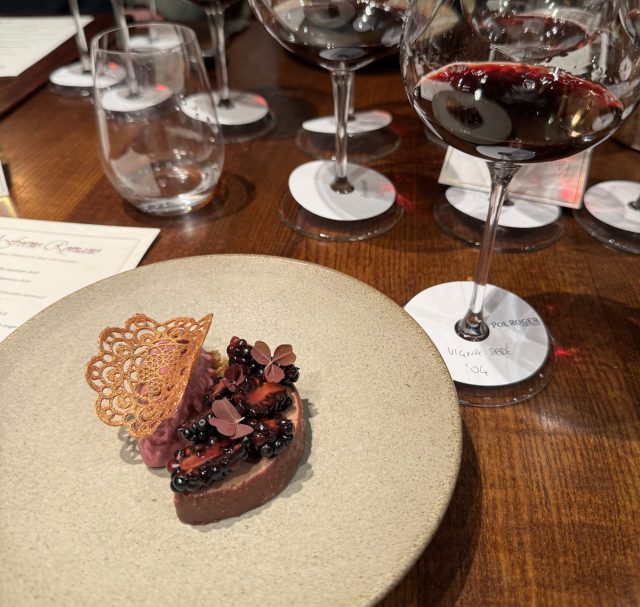This website uses cookies so that we can provide you with the best user experience possible. Cookie information is stored in your browser and performs functions such as recognising you when you return to our website and helping our team to understand which sections of the website you find most interesting and useful.
No smoke without fire: pairing picks for Dal Forno Romano
A recent lunch showcased Dal Forno Romano’s Amarone, Valpolicella Superiore and passito rosso alongside wood-smoked, Scandinavian-inflected cookery. Louis Thomas sinks his teeth into some of the unconventional pairings.

The event, marking the release of the Val d’Illasi-based producer’s 2018s, the fourth vintage it has launched in the UK through Pol Roger Portfolio, was held at Ekstedt at The Yard, in Great Scotland Yard Hotel.
While Nordic-inflected cuisine might not seem to be an obvious match, the menu to complement the Dal Forno Romano range had been specially designed for the occasion by the restaurant’s head chef Luca Mastrantoni, and head sommelier Klearhos Kanellakis.
Valpolicella Superiore with oysters and mushrooms
The first pairing was to complement Ekstedt’s signature dish, the flambadou oyster. This highly theatrical opening consists of scorching hot metal cone with a hole in the bottom being filled with beef tallow, with the flaming stream of hot fat then dribbled over oysters, causing a great deal of sputtering and smoking.
To pair, the 2016 Valpolicella Superiore was chosen. Launched last year, and later than the 2017 due it needing more time in the bottle, the 2016 is what export manager Marco Pinna dubbed “a perfect vintage”: “A fresh spring with a balanced temperature – not too high, not too low – the quantity was low because we were hit by a hailstorm at the end of May 2015, and that compromised the production for the following year.”
Red wine and shell fish might seem an odd combination, but Ekstedt’s flambadou is, thanks with it hot fat shower, beefy, smoky, and also partially cooked, and so the Valpolicella Superiore’s tannins and tertiary edge made it an excellent match – though it is still fairly restrained, likely needing another decade to really show itself.

Dal Forno Romano’s 2018 Valpolicella Superiore, which was one of the wines being launched at the lunch, hailed from a vintage which did not have 2016’s yield issues, as Pinna explained: “2018 started with a mild winter, then the temperature dropped. In May it started to rain and we were hit by two hailstorms, which didn’t compromise the quantity or quality. In fact, the quantity was 30% more than usual – normally we would produce 65,000 bottles, but for 2018 we made 85,000.”
The 2018 is also half a degree more alcoholic than the 2016, with an ABV of 14.5%. This was paired with a dish we were told to consume “like Swedish tacos” – pickled, fermented and raw mushrooms, juniper butter, lingonberry, shallot and parsley were placed into a 300°C cast iron bowl, stirred around, and then served atop tunnbrod (a Nordic flatbread).
The more exuberant 2018 paired well with such an eclectic combination of flavours, though the feeling at the table was that it is the 2016 will stand the test of time better than its younger brother. Both underwent around a month and a half of appassimento, with Dal Forno Romano perhaps being unusual for a producer in Valpolicella in that it works entirely with grapes that have undergone some drying. Corvina makes up about 60% of the blend of all of its wines, with the remainder constituting of Corvinone (10%), Rondinella (5%), Croatina (15%) and Oseleta (10%).
Amarone della Valpolicella with smoked meat
The next course brought even more of the wood smoke that one comes to expect from a Niklas Ekstedt restaurant.
Hay-smoked beef tartare with black truffle was certainly a far cry from the classic with capers and cornichons, with the smoke acting as the main flavouring. A tartare of this intensity needs a wine to match it.
This was served alongside the newly-released 2018 Amarone della Valpolicella, and also a 2012 expression which had been stored in magnum.
Dal Forno Romano releases its large formats, from magnum upwards, 10 years after the harvest, for both its Valpolicella Superiore and Amarone, though there will be no 2014 of the latter out this year as none was produced due to a “challenging vintage”. The oak ageing regime for these later releases is the same as usual (the 2012 spent a total of 24 months in French oak barrique), but the period of maturation in bottle is substantially prolonged.
“The colour of the ’12 is the same as the ’18,” Pinna pointed out. “This is because we work in reduction with a vacuum system replacing the air with nitrogen, helping to fix the colour and avoid oxidation.”
Pinna suggested that larger formats do lend themselves better to longer bottle ageing: “The 2012 in a normal 75cl bottle will be different. The magnum isn’t ‘fresher’ per se, but a 2012 in a regular bottle will taste three years older – the evolution in magnums is better.”

In this instance, the 2012 was the better pairing, with its earthy quality being particular pleasant alongside the black truffle, though, at present, the fruit-forward ’18 lends itself better to drinking on its own than the ’12. What is surprising upon a look of the technical data on both these vintages is the disparity in residual sugar levels – the 2018 has 5.6 grams per litre to the 2012’s 1.4. You feel the sugar in the texture, rather than necessarily taste sweetness. Much like the use of smoke in the tartare, the level of sugar here is in order to round the wine out.
Following this, Dal Forno Romano’s 2009 Amarone was then poured alongside the main of pine-smoked duck.
This was the best example of adjusting a dish to the wine’s qualities, as each of the side components played a role in perfecting the pairing: the beetroot purée with the added flavour of elderflower gave earthiness and a slight floral lift, the oyster mushroom provided an intensely savoury quality, and the chocolate jus was rich and had a slight bitterness. By mirroring the wine’s flavour profile, there was a harmony between what was on the plate and what was in the glass. With 7.9g/l, the 2009 also had the highest residual sugar level of any of the Amarones tasted that day, though, again, it does not jut out.
Perhaps the biggest takeaway from the meal was that Amarone works exceptionally well with smoked red meat – the slightly higher alcohol, touch of residual sugar, and concentration of tannins mean that they don’t just hold up against these dishes, they mellow what could otherwise be an overwhelmingly smoky flavour. The medium toasting of the barriques also gives a subtle smoky quality to the wines that would only help. Given that Texas-style BBQ is starting to appear on this side of the Atlantic, thanks in part to social media hype, Amarone della Valpolicella could well be the ideal wine to serve alongside smoked brisket.
Passito rosso with chocolate
While over sweetness is not desired in Dal Forno Romano’s Amarone, it very much is for its Vigna Seré Passito Rosso – the 2004 vintage of which has a residual sugar level of 113g/l.
The elephant in the room is that Valpolicella already has a sweet wine with DOCG status (as of 2009), Recioto, and yet Dal Forno Romano calls its expression ‘Passito Rosso’, and it is designated as Veneto IGT.
In 2003, Dal Forno Romano was refused the right to use the term ‘Recioto’ for Vigna Seré as it no longer met the production regulations, with commission claiming it to be too ‘astringent’ to meet its standards for a Recioto.
“We had the labels ready,” Pinna revealed, “so we had to change everything. We didn’t use ‘Recioto’ on the label, but it is basically a ‘Recioto’, which is the oldest wine in Valpolicella – people say that Amarone was actually a mistake in Recioto production and the wine tasted bitter, or ‘amaro’.”
As it happens, 2004 is the latest vintage of the wine, and it had only produced in five other years prior to that harvest. With the berries (the majority of which are Corvina) requiring three months of drying, it is, according to Pinna, “the most difficult wine to produce”.

Cheese would have been excellent with this, though probably not the best display of culinary flair. Instead, a dark chocolate mousse (smoked, of course) with blackberries, both in fresh form and as an ice cream, was served. Dark fruits, bitter chocolate and, again, that smoky element proved to be another winning combination. Certainly not sickly, with a level of acidity high enough to balance out the sugar, and far from ‘astringent’, it’s just a shame that Dal Forno Romano hasn’t made any for 20 years.
Related news
Viña Maquis: why 2014 and 2020 were right for this year's La Place campaign

